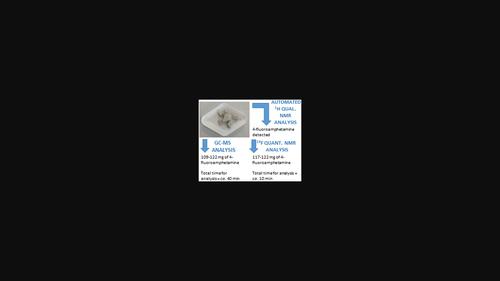当前位置:
X-MOL 学术
›
Magn. Reson. Chem.
›
论文详情
Our official English website, www.x-mol.net, welcomes your
feedback! (Note: you will need to create a separate account there.)
Detection, discrimination and quantification of amphetamine, cathinone and nor-ephedrine regioisomers using benchtop 1H and 19F nuclear magnetic resonance spectroscopy
Magnetic Resonance in Chemistry ( IF 1.9 ) Pub Date : 2021-03-30 , DOI: 10.1002/mrc.5156 Matthew C Hulme 1, 2 , Armita Hayatbakhsh 1 , Rachel M Brignall 3 , Nicolas Gilbert 1, 2 , Andrew Costello 2, 4 , Christopher J Schofield 2, 4 , David C Williamson 3 , E Kate Kemsley 5 , Oliver B Sutcliffe 1, 2 , Ryan E Mewis 1, 2
Magnetic Resonance in Chemistry ( IF 1.9 ) Pub Date : 2021-03-30 , DOI: 10.1002/mrc.5156 Matthew C Hulme 1, 2 , Armita Hayatbakhsh 1 , Rachel M Brignall 3 , Nicolas Gilbert 1, 2 , Andrew Costello 2, 4 , Christopher J Schofield 2, 4 , David C Williamson 3 , E Kate Kemsley 5 , Oliver B Sutcliffe 1, 2 , Ryan E Mewis 1, 2
Affiliation

|
Amphetamine and cathinone derivatives are abused recreationally due to the sense of euphoria they provide to the user. Methodologies for the rapid detection of the drug derivative present in a seized sample, or an indication of the drug class, are beneficial to law enforcement and healthcare providers. Identifying the drug class is prudent because derivatisation of these drugs, to produce regioisomers, for example, occurs frequently to circumvent global and local drug laws. Thus, newly encountered derivatives might not be present in a spectral library. Employment of benchtop nuclear magnetic resonance (NMR) could be used to provide rapid analysis of seized samples as well as identifying the class of drug present. Discrimination of individual amphetamine-, methcathinone-, N-ethylcathinone and nor-ephedrine-derived fluorinated and methylated regioisomers is achieved herein using qualitative automated 1H NMR analysis and compared to gas chromatography–mass spectrometry (GC–MS) data. Two seized drug samples, SS1 and SS2, were identified to contain 4-fluoroamphetamine by 1H NMR (match score median = 0.9933) and GC–MS (RRt = 5.42–5.43 min). The amount of 4-fluoroamphetamine present was 42.8%–43.4% w/w and 48.7%–49.2% w/w for SS1 and SS2, respectively, from quantitative 19F NMR analysis, which is in agreement with the amount determined by GC–MS (39.9%–41.4% w/w and 49.0%–49.3% w/w). The total time for the qualitative 1H NMR and quantitative 19F NMR analysis is ~10 min. This contrasts to ~40 min for the GC–MS method. The NMR method also benefits from minimal sample preparation. Thus, benchtop NMR affords rapid, and discriminatory, analysis of the drug present in a seized sample.
中文翻译:

使用台式 1H 和 19F 核磁共振波谱检测、鉴别和定量苯丙胺、卡西酮和去甲麻黄碱区域异构体
安非他明和卡西酮衍生物因给使用者带来欣快感而被滥用于消遣。快速检测缉获样品中存在的药物衍生物或指示药物类别的方法有利于执法和医疗保健提供者。确定药物类别是谨慎的,因为这些药物的衍生化,例如,生产区域异构体,经常发生以规避全球和当地的药物法律。因此,新遇到的衍生物可能不存在于光谱库中。台式核磁共振 (NMR) 的使用可用于提供对缉获样品的快速分析以及识别存在的药物类别。个别苯丙胺、甲卡西酮、N-乙基卡西酮和去甲肾上腺素的区分此处使用定性自动1 H NMR 分析并与气相色谱-质谱 (GC-MS) 数据进行比较,获得了麻黄碱衍生的氟化和甲基化区域异构体。通过1 H NMR(匹配分数中位数 = 0.9933)和 GC-MS(RR t = 5.42-5.43 分钟)鉴定出两个缉获的药物样品 SS1 和 SS2 含有 4-氟苯丙胺。根据定量19 F NMR 分析,SS1 和 SS2 的 4-氟苯丙胺含量分别为 42.8%–43.4% w/w 和 48.7%–49.2% w/w,这与 GC- MS(39.9%–41.4% w/w 和 49.0%–49.3% w/w)。定性1 H NMR 和定量19的总时间F NMR 分析约为 10 分钟。这与 GC-MS 方法的 ~40 分钟形成对比。NMR 方法还受益于最少的样品制备。因此,台式 NMR 可对检获样品中存在的药物进行快速且具有鉴别力的分析。
更新日期:2021-03-30
中文翻译:

使用台式 1H 和 19F 核磁共振波谱检测、鉴别和定量苯丙胺、卡西酮和去甲麻黄碱区域异构体
安非他明和卡西酮衍生物因给使用者带来欣快感而被滥用于消遣。快速检测缉获样品中存在的药物衍生物或指示药物类别的方法有利于执法和医疗保健提供者。确定药物类别是谨慎的,因为这些药物的衍生化,例如,生产区域异构体,经常发生以规避全球和当地的药物法律。因此,新遇到的衍生物可能不存在于光谱库中。台式核磁共振 (NMR) 的使用可用于提供对缉获样品的快速分析以及识别存在的药物类别。个别苯丙胺、甲卡西酮、N-乙基卡西酮和去甲肾上腺素的区分此处使用定性自动1 H NMR 分析并与气相色谱-质谱 (GC-MS) 数据进行比较,获得了麻黄碱衍生的氟化和甲基化区域异构体。通过1 H NMR(匹配分数中位数 = 0.9933)和 GC-MS(RR t = 5.42-5.43 分钟)鉴定出两个缉获的药物样品 SS1 和 SS2 含有 4-氟苯丙胺。根据定量19 F NMR 分析,SS1 和 SS2 的 4-氟苯丙胺含量分别为 42.8%–43.4% w/w 和 48.7%–49.2% w/w,这与 GC- MS(39.9%–41.4% w/w 和 49.0%–49.3% w/w)。定性1 H NMR 和定量19的总时间F NMR 分析约为 10 分钟。这与 GC-MS 方法的 ~40 分钟形成对比。NMR 方法还受益于最少的样品制备。因此,台式 NMR 可对检获样品中存在的药物进行快速且具有鉴别力的分析。











































 京公网安备 11010802027423号
京公网安备 11010802027423号